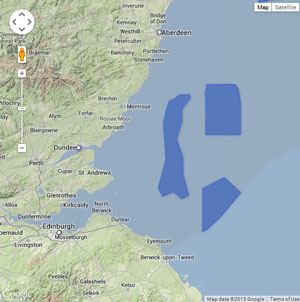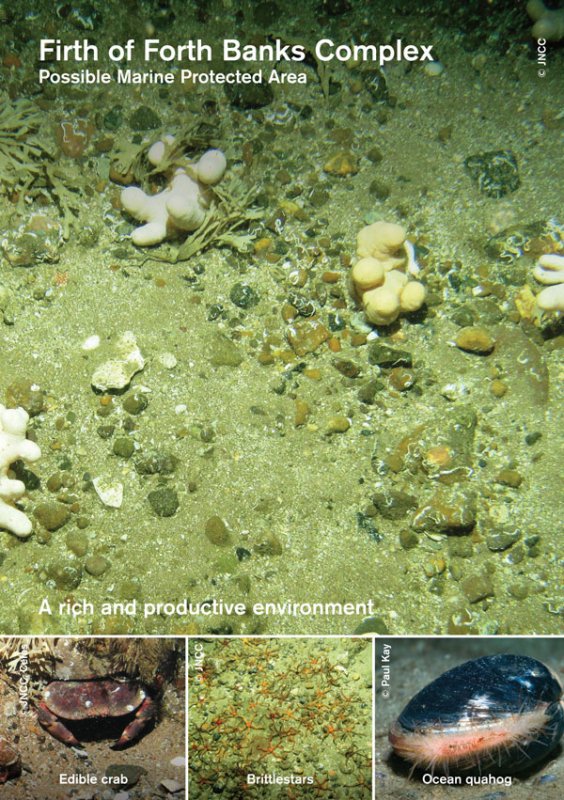 In the waters offshore of Angus, Fife and the Borders coasts, the Firth of Forth Banks Complex is an area of sandy and gravely seabed critical to the wider health of Scotland’s seas.
In the waters offshore of Angus, Fife and the Borders coasts, the Firth of Forth Banks Complex is an area of sandy and gravely seabed critical to the wider health of Scotland’s seas.
The MPA holds the Montrose, Berwick, Scalp and Wee Bankie seabanks, which are known to provide wide-ranging benefits to the seas all along the east coast. The Berwick Bank is a key spawning ground for Plaice and the seabirds and seals that nest and haul-out all along the coastlines nearby, travel out to the area to hunt for food.
In the sands and gravels of the site, a rich diversity of flora and fauna live, with molluscs, crabs, bottom feeding fish and big aggregations of ocean quahog. Ocean quahog are a bivalve mollusc, a shell that we often see along our coasts, and they can live to be over 400 years old. They make up part of the complex seabed habitat that is so important to the site. But the most important feature in this proposal is the sandeel.
Sandeels are a small species of fish that live in the sandy seabed found in the MPA area. They spend much of their time buried in the seabed but during spring and summer they emerge and swim in the water column to feed and to spawn. During this time they become prey to larger species and they make up such a huge prey base that some of these species are now reliant upon them. Seabirds, seals and other fish species throughout the East Scotland region are supported by this boom in sandeel numbers and so it is critical that they are properly protected. Their distribution is patchy and so it is vital that this, their key stronghold in Scotland, is protected over others.
Management measures for this site were proposed by Scottish Government late last year. Save Scottish Seas campaign members have assessed the Scottish Government’s management proposals for this site as part of its consultation response.
Read our comment on the proposed management measures here:
LINK members support the proposals to restrict mobile demersal fishing gear (excluding seine
trawls) on areas of mapped ocean quahog distribution. However, we suggest extending the
management measures to protect more deep circalittoral coarse sediment (i.e. Wee Bankie) to
increase representation and to provide a wider buffer around mapped ocean quahog aggregations.
Confirmed ocean quahog aggregations occur where fishing intensity is lower and where there are
Nephrops sp. it is likely that quahogs are not present. Therefore we suggest extending management
to areas where there is currently no/limited mobile demersal gear to increase the amount of
suitable habitat available for further quahog aggregation expansion, given that previous fishing
activity may have reduced ocean quahog extent. We also restate the SNH advice for a more
precautionary approach to management of this species due to the uncertainty in determining
distribution, in estimating the area required to support a minimum population, the low expected
recovery rate and their vulnerability to physical disturbance such as bottom trawling.Additionally, we still have concerns that sandeels were not accepted as a designated feature for this
site due to the protection afforded by the east of Scotland sandeel fisheries closure. However, given
the keystone ecosystem role of sandeels, it is critical that areas important to sandeels are given
adequate protection from all pressures. We therefore suggest that the review of the MPA network
should consider sandeels as a protected feature for this site.
Read our comment on the 2013 site proposal here:
LINK supports the designation of the Firth of Forth Banks Complex possible Nature
Conservation MPA.
Firth of Forth Banks Complex must be designated. Its alternatives are of a lesser
ecological value and it is one of the most important areas on the Scottish east
coast, supporting the marine ecosystem function through its importance for and
provision of sandeels.
We draw attention to the JNCC advice, repeated in the management options
paper, that the two ‘science-based’ alternatives “do not make equivalent
contributions to the network to that made by the Firth of Forth Banks Complex
possible MPA” and that “the Firth of Forth Banks Complex is JNCC’s preferred
possible MPA to go forward for designation”. We strongly support this position.
LINK would therefore consider designation of any alternative as a failure to follow
the scientific advice provided by JNCC and a contradiction with the ministerial
decision to do exactly that.
LINK supports this designation on the basis of the advice provided showing that
this possible MPA represents a more diverse habitat mosaic and wider range of
constituent marine species compared to the alternative possible MPA options
presented. Also that the geographic location, and local physico-chemical drivers of
the Firth of Forth Banks Complex have also led to the evolution of an ecosystem
that is not replicated by the alternative possible MPA options.
However, LINK also notes that the possible MPA contains a significant population
of the sandeel PMF, and that this feature plays an extremely important role in the North Sea ecosystem, and particularly for pisciverous predators on the east coast
which rely on this species, such as grey seal, harbour seal, harbour
porpoise66, common guillemot, razorbill, black-legged kittiwake, puffin and
northern gannet.For this reason we strongly urge Scottish Government to add
sandeels as a protected feature within this site. It has previously been suggested
that this is not necessary because the pMPA falls within the North-east Sandeel
Closure (CA1). However, this is only protecting sandeels from direct fishing
pressure. Being listed as a protected feature would ensure appropriate
assessment is made for any activity undertaken in the area, and given that
research has already shown sandeels in this area are undersized, the opportunity provided by this MPA to recover the species and the ecosystem must
not be overlooked and as such sandeels must be added as a protected feature.
Such an amendment to the designation order will allow appropriate and adequate
assessment of the impacts to the local and regional population of this feature as
well as any indirect consequences to ensure they are avoided and minimised.
LINK also fully support the designation of the ocean quahog aggregations and
offshore subtidal sands and gravels search features.
Check out the official documents relating to the Firth of Forth Banks Complex MPA on the Joint Nature Conservation Committee website.

